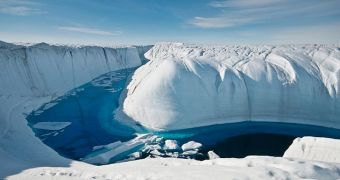The Antarctic polar icecap is a whopping 33.6 million years old, a study recently published in the journal Science says.
Using carbon-dating technologies, scientists with the University of Granada and the Spanish National Research Council have found that this icecap formed during the Oligocene.
They say that, before the Antarctic got covered in ice, this part of our planet was pretty much teeming with life, courtesy of a warm tropical climate.
Once temperatures began to drop, local plants and animals had to choose between adapting to the new environmental conditions and perish.
Needless to say, most life forms disappeared and only a handful managed to survive on the longer run.
The plankton communities roaming these regions nowadays made their appearance at this point in the Antarctica's history, the researchers explain.
Their activity was and still is determined by the local seasonal climate, meaning that they only get to flourish when the ice melts and starts freeing the nutrients trapped inside it.
“The fossil record of dinoflagellate cyst communities reflects the substantial reduction and specialization of these species that took place when the ice cap became established and, with it, marked seasonal ice-pack formation and melting began,” researcher Carlota Escutia says.

 14 DAY TRIAL //
14 DAY TRIAL //